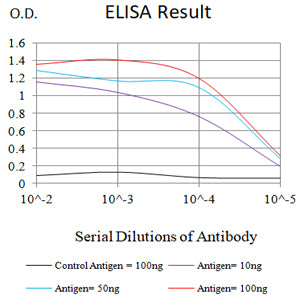
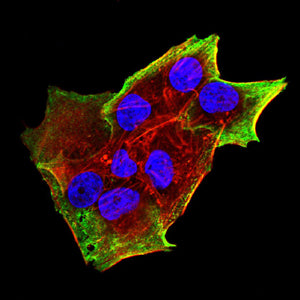
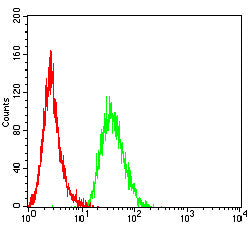
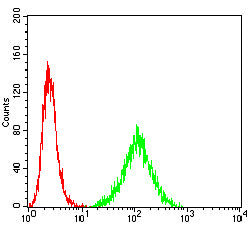
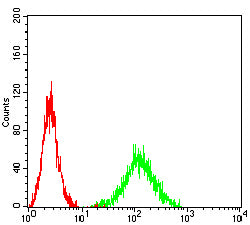
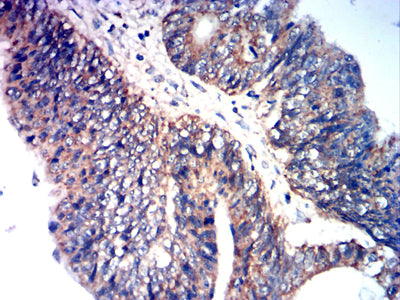
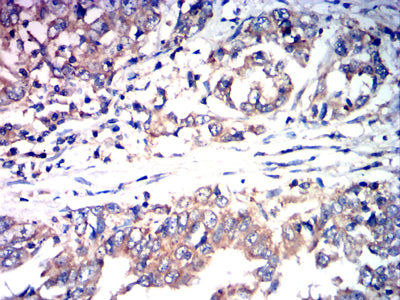
| WB | 咨询技术 | Human,Mouse,Rat |
| IF | 咨询技术 | Human,Mouse,Rat |
| IHC | 1/200 - 1/1000 | Human,Mouse,Rat |
| ICC | 1/200 - 1/1000 | Human,Mouse,Rat |
| FCM | 1/200 - 1/400 | Human,Mouse,Rat |
| Elisa | 1/10000 | Human,Mouse,Rat |
| Aliases | ALP; ILC; CTAK; CTACK; PESKY; ESKINE; SCYA27 |
| Entrez GeneID | 10850 |
| clone | 3B7A5 |
| WB Predicted band size | 12.6kDa |
| Host/Isotype | Mouse IgG1 |
| Antibody Type | Primary antibody |
| Storage | Store at 4°C short term. Aliquot and store at -20°C long term. Avoid freeze/thaw cycles. |
| Species Reactivity | Human |
| Immunogen | Purified recombinant fragment of human CCL27 (AA: 25-112) expressed in E. Coli. |
| Formulation | Purified antibody in PBS with 0.05% sodium azide |
+ +
1. **"CCL27-CCR10 interactions regulate T cell-mediated skin inflammation"**
*Authors: Homey B, et al.*
摘要:该研究阐明了CCL27与其受体CCR10在皮肤炎症中的关键作用,利用特异性抗体阻断CCL27可减少T细胞向皮肤迁移,缓解小鼠皮炎模型症状。
2. **"Targeting CCL27 in cutaneous T-cell lymphoma: A therapeutic strategy"**
*Authors: Morales J, et al.*
摘要:研究发现CCL27抗体能抑制皮肤T细胞淋巴瘤(CTCL)细胞增殖并诱导凋亡,表明其作为CTCL靶向治疗的潜在价值。
3. **"CCL27 modulates dendritic cell function to promote cutaneous immunity"**
*Authors: Soler DC, et al.*
摘要:通过抗体中和实验证明,CCL27通过调控树突状细胞活性影响皮肤免疫应答,为银屑病等自身免疫性皮肤病提供机制解释。
4. **"Anti-CCL27 antibody attenuates allergic contact dermatitis in murine models"**
*Authors: Fujita H, et al.*
摘要:在小鼠接触性皮炎模型中,CCL27抗体显著减少嗜酸性粒细胞浸润和Th2细胞因子释放,提示其在过敏性疾病中的治疗潜力。
CCL27. also known as cutaneous T-cell-attracting chemokine (CTACK), is a small chemokine belonging to the CC subfamily. It is primarily produced by keratinocytes in the skin and interacts with the CCR10 receptor, playing a critical role in immune surveillance and inflammatory responses. CCL27 facilitates the recruitment of CCR10-expressing T cells, particularly memory T lymphocytes, to cutaneous sites, making it essential for maintaining skin-specific immune homeostasis. Its expression is upregulated under inflammatory conditions, such as atopic dermatitis, psoriasis, and allergic contact dermatitis, implicating it in the pathogenesis of chronic skin disorders. Additionally, CCL27 has been linked to tumor immunity, as aberrant expression is observed in cutaneous T-cell lymphoma and melanoma.
CCL27 antibodies are immunological tools designed to detect or neutralize CCL27 protein activity. Polyclonal and monoclonal antibodies against CCL27 are widely used in research to study its biological functions, including ligand-receptor interactions, immune cell trafficking, and inflammatory signaling pathways. These antibodies enable techniques like ELISA, Western blotting, immunohistochemistry, and flow cytometry to quantify CCL27 levels in tissues or fluids, map its distribution, and assess its role in disease models. Neutralizing antibodies, in particular, are employed to block CCL27/CCR10 signaling in experimental settings, providing insights into therapeutic targeting for inflammatory skin diseases or cancer. The development and validation of CCL27 antibodies continue to support advances in dermatology, immunology, and oncology research.
×